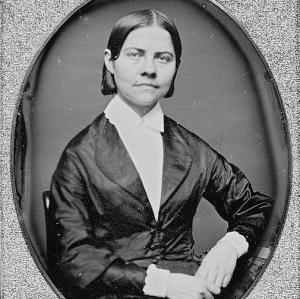Lucy Stone

A leading suffragist and abolitionist, Lucy Stone dedicated her life to battling inequality on all fronts. She was the first Massachusetts woman to earn a college degree and she defied gender norms when she famously wrote marriage vows to reflect her egalitarian beliefs and refused to take her husband’s last name.
Born on August 13, 1818 in rural Massachusetts, Stone was one of Francis and Hannah Matthews Stone’s nine children. Her parents were farmers with deep roots in New England. The first Stones arrived in 1635 pursuing religious freedom and her grandfather was a Patriot captain in the American Revolution. She was raised in the Congregational Church and embraced her father’s anti-slavery zeal.
Much brighter than her brothers, Stone was frustrated by the inequality that encouraged them to attend college while discouraging women from becoming educated. At age sixteen, she worked as a teacher, saving her money so she could attend college. In 1839, she spent a semester at Mount Holyoke, but was forced to return home due to a sister’s illness. Then in 1843, she attended Oberlin College in Ohio. Even progressive Oberlin, however, did not permit Stone to explore her interest in public speaking. When she graduated in 1847, she declined the “honor” of writing a commencement speech that would be read by a man.
Almost thirty when she completed her education, Stone’s career prospects seemed dim since few professions were open to women. Renowned abolitionist William Lloyd Garrison, however, hired her for his American Anti-Slavery Society. She wrote and delivered abolitionist speeches, while also becoming active in women’s rights. Like other female abolitionists, Stone was often heckled and at least once was physically attacked by a mob. Nevertheless, she proved so popular that soon she was out-earning many male lecturers.
In 1850, two years after the Seneca Falls Women’s Rights Convention, Stone organized the first national Women’s Rights Convention in Worcester, Massachusetts. Her speech there was reprinted in the international press. For five years, Stone traveled throughout the US and Canada on the lecture circuit. She continued to attend annual women’s rights conventions and presided over the seventh one. She met Henry Blackwell, the brother of physicians Elizabeth and Emily Blackwell, who convinced her to marry him by promising they could create an egalitarian marriage. Intended for publication, their 1855 vows omitted the then-common reference to wifely obedience and included a protest against marital law. She also set a new standard by retaining her maiden name. While living in New Jersey, Stone gave birth to two children, though the second one did not survive. Daughter Alice Stone Blackwell became a feminist and abolitionist, working alongside her parents.
Stone set another precedent in 1858 when she reminded Americans of the “no taxation without representation” principle. Her refusal to pay property taxes was punished by the impoundment and sale of the Stones’ household goods. At the end of the Civil War, Stone went to Kansas to work on the referendum for suffrage there. She also served as president of the New Jersey Women Suffrage Association and helped organize the New England association, in which she would be active after the family moved to Boston in 1869. At the same time, Stone served on the executive committee of the American Equal Rights Association.
In 1869, Stone broke with suffragists Elizabeth Cady Stanton, Susan B. Anthony, and others over passage of the 14th and 15th Amendments to the Constitution, which granted voting rights to black men but not to women. Stone was willing to accept this measure for her abolitionist goals while continuing to work for women’s suffrage. Anthony and Stanton formed the National Woman Suffrage Association (NWSA). Stone, Julia Ward Howe, and others formed the American Woman Suffrage Association (AWSA). Stone edited the AWSA publication, the Woman’s Journal. In 1879, Stone registered to vote in Massachusetts, since the state allowed women’s suffrage in some local elections, but she was removed from the rolls because she did not use her husband’s surname.
Stone lived to see the reunification of the two suffrage associations in 1890; both her daughter and Stanton’s daughter, Harriot Stanton Blatch, played important roles in healing their mothers’ wounds. Stone gave her last speech in 1893 at the World’s Columbian Exposition, and died later that year at age seventy-five.
-
Louis Filler, “Lucy Stone,” in Edward T. James, Janet Wilson James, and Paul Boyer, editors, Notable American Women, 1607-1950: A Biographical Dictionary (Cambridge: Belknap Press of Harvard University, 1971), p. 387-390.
-
McMillen, Sally G. Lucy Stone: An Unapologetic Life. (Oxford University Press, 2015).
-
PHOTO: Library of Congress
MLA – Michals, Debra. “Lucy Stone.” National Women’s History Museum, 2017. Date accessed.
Chicago – Michals, Debra “Lucy Stone.” National Women’s History Museum. 2017. www.womenshistory.org/education-resources/biographies/lucy-stone.
Books:
-
Kerr, Andrea Moore. Lucy Stone: Speaking Out for Equality. (Rutgers University Press, 1992).
-
Lasser, Carol and Marlene Deahl Merrill. Friends and Sisters: Letters Between Lucy Stone and Antoinette Brown Blackwell 1846-1893 (University of Illinois Press, 1987).
-
Millions, Joelle. Woman’s Voice, Woman’s Place: Lucy Stone and the Birth of the Woman’s Rights Movement (Praeger, 2003).
-
Stone, Lucy. Loving Warriors: Selected Letters of Lucy Stone and Henry B. Blackwell, 1853 to 1893. (Doubleday, 1981).
Web Sites:
-
Library of Congress: Votes for Women: the National American Woman Suffrage Association Collection, 1848-1921
http://memory.loc.gov/ammem/naw/nawshome.html. -
American National Biography: http://www.anb.org/articles/15/15-00663.html
-
National Parks Service https://www.nps.gov/wori/learn/historyculture/lucy-stone.htm
-
Boston Women’s Heritage Trail: http://bwht.org/lucy-stone/
-
Ohio History Central Connection: http://www.ohiohistorycentral.org/w/Lucy_Stone
-
Mass Moments: http://www.massmoments.org/moment.cfm?mid=235
-
Oberlin Magazine timeline of Lucy Stone: http://www2.oberlin.edu/alummag/spring2004/feat_lucy_timeline_popup.html




